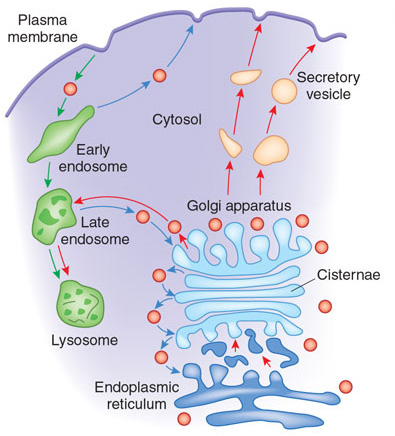The thickness of this universal bio material is known, it is two molecules thick or about 4 nm (nano meter or 1/1000 microns or 10 to the power -9 meters). For comparison, the size of a diamond cubic crystal made of 8 atoms is about 0.35 nm.
One of the methods of visualizing a virus within a tissue is by freezing and cutting that piece containing viruses with a micro-tome equipped with a knife made of diamond. However you cannot sharpen diamond to obtain an edge one atom thick, and even if you could it would break before cutting anything. One of the smallest commercially available diamond knife is about 12 atoms or 2 nm radius or 4 nm thick.
Because of that a cross section through a cell's or virus's membrane would be more of a tear than a cut.
Most viruses have around 100 nm diameter. To see a cross section of a virus you have to cut slices of the tissue suspected to have viruses in it and then you look under electron microscope to see if you caught/cut a virus in two.
Eukariotic cells are those which made up multicellular organisms. Their two molecule thick lipid bylayer membrane is very fragile but they are encapsulated in collagen extracellular tissue (or cellulose in case of plants) that also holds an organ together and has some mechanical resistance.
Here are images of collagen extracellular matrices in cut cross sections in various stages of degradation because of induced illnesses in mice, last one being most porous, after they have been stripped of cells with some chemicals.

Usually represented through graphs, there are also images of cross sections of whole cells taken under electron microscope, though is hard to catch in a single image all types of organelles within one single cell in a cut sample. But i would assume if you have enough time and patience you would find a cell that has been cut in such a way it has all of those visible.
Coincidentally this cell is seen with two open vesicles in the lower right side which means the cell is dying because some of its organelles are already used to produce viruses. It can also be a cultured cell, that is not wrapped yet in a connective tissue matrix.
To me it is hard to believe a cell would produce something that would infect and kill other cell, that is viruses.
But how most viruses that are enveloped only in a fragile bylayer membrane can escape the hard collagen connective tissue enclosure of the cell. I believe the answer probably is viruses can only propagate within already damaged tissue or weakened or porous matrix which is not intact and can be an evolutionary mechanism through which cells that are not completely encapsulated are killed. (2 micrometers mean 2000 nanometers).
There is a type of cells that specialize in maintaining and regenerating the connective tissue. They are called fibroblasts. However sometimes tissues cannot be repaired and they are replaced with scar tissues which is mostly made of collagen like in the case of cirrhosis of the liver. But there are no fiberblasts in the extracellular matrix surrounding cells. That one is secreted by the cells themselves.
But it could happen some people are so depleted of collagen from previous repairs like in case in chronic ulcerations, or simply a poor diet, that their cellular matrix is so thin is permeable to things as fragile as viruses. One way to know is examining old scars that used to be firm and then turned into very soft tissue.
Once the matrix become permeable, not only viruses and bacteria but the cells themselves start to penetrate and divide outside, right the border of the matrix, especially in weakened or damaged areas and if they are too many close to each other they start building a different kind of matrix we all know as cancer. Unlike viruses and bacteria they are not recognized as harmful but your organism's immune system.
However it is unclear to me from all i could find how cells divide inside the extracellular matrix where every cell seems to have its own place made of collagen fiber.
It is obvious there is not enough room for two daughter cells inside a single "room", one of them has to die. I would assume that after division there is a competition between the two daughters and only the most viable survives. But if cells start dividing outside the matrix, they will all probably live for ever inculcating the mutant ones and the ones closest to the old matrix will start building their own aberrant matrix.
Could it be peaks during chemo kill the cells that are dividing freely just outside the matrix more than the ones inside.
It is known that collagen fibers are too big to penetrate human intestine. All it can go in your blood stream within a healthy intestine is broken down through digestion small molecules of monosaccharides, amino-acids, fatty acids and minerals.
However, if you take collagen supplements or eat collagen rich foods like bone broth or hot dogs, those are broken down in your intestine during digestion to the exact type of amino-acids and minerals needed by the fibroblasts or cells to produce collagen.
I believe a healthy cellular matrix in all organs is key in cancer prevention and it can be maintained through a proper diet and also by treating all chronic inflammations and ulcerations in your body that are usually caused by an unavoidable toxic environment with dust, mold and bacteria.
































